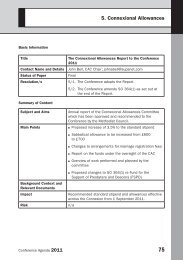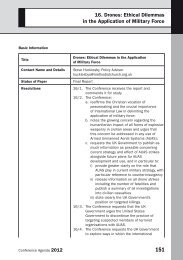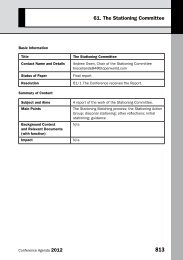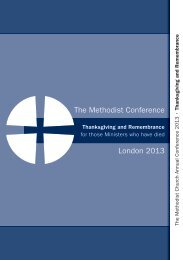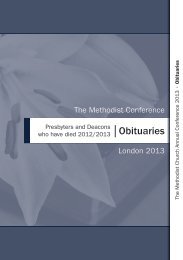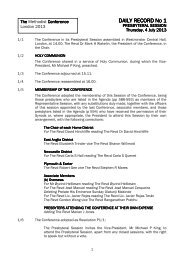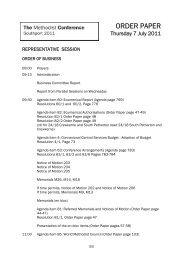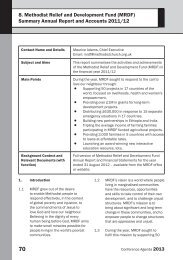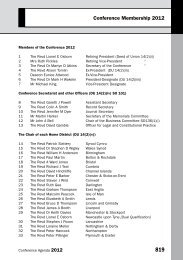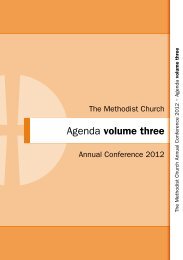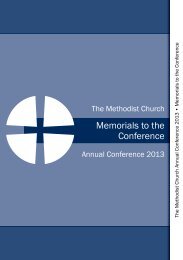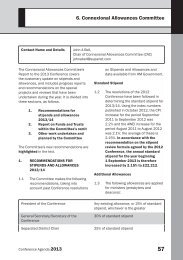Agenda Volume 2 - Methodist Conference
Agenda Volume 2 - Methodist Conference
Agenda Volume 2 - Methodist Conference
You also want an ePaper? Increase the reach of your titles
YUMPU automatically turns print PDFs into web optimized ePapers that Google loves.
35. Larger than Circuit<br />
actually involved in district life. The<br />
reports the working party receives<br />
- of district strategy documents,<br />
district reviews, district-wide<br />
inspirational events - indicate that<br />
there is in many places a developing<br />
awareness of the key role which the<br />
district can play in enabling local<br />
churches and circuits to fulfil their<br />
calling to mission.<br />
c. Working with other Districts<br />
48. Alongside this focus upon the role<br />
and strategy of the district, there is<br />
the increasing practice for districts<br />
not to ‘go it alone’, but to work with<br />
neighbouring districts in making key<br />
appointments, some of which are<br />
described below. Where necessary,<br />
this has been encouraged by Standing<br />
Orders permitting, for instance, the<br />
joint appointment of Reconciliation<br />
and Support Groups for the<br />
complaints and discipline processes.<br />
49. In some aspects, the need not to ‘go<br />
it alone’ has been recognised and<br />
actually become formalised over<br />
the years onto a regional basis. The<br />
grouping of districts in stationing<br />
regions dates back over many<br />
years, and has become increasingly<br />
significant in the stationing process.<br />
The current regional training<br />
networks, each with its forum, are a<br />
more recent example, and now we<br />
have the proposed regional groupings<br />
for the emerging Discipleship and<br />
Ministries Learning Network. It<br />
should be said that greater value has<br />
been placed on regionalism in some<br />
parts of the connexion than others.<br />
Some regional groupings of districts<br />
have been able for various reasons<br />
to develop more effective ways of<br />
working together than others, for<br />
instance the covenant relationship<br />
which came about as a result of<br />
the North West Districts’ Review<br />
Group 7 .<br />
d. Regrouping for Mission<br />
50. As was explained at the outset,<br />
this report has its genesis in the<br />
process of Regrouping for Mission<br />
which, within and across our circuits<br />
over recent years, has amounted to<br />
an intense period of engagement<br />
with the patterns and structures<br />
of church life and significant<br />
change. Key reflections from the<br />
work of Regrouping for Mission<br />
include the importance of having<br />
a clear understanding of the aims<br />
and purposes of the patterns and<br />
structures of church life, and the<br />
importance of being willing to<br />
change these patterns and structures<br />
if existing patterns and structures no<br />
longer match our aims and purposes.<br />
51. It was always envisaged that the<br />
process would raise significant<br />
7 . Note that although the review refers to the ‘North<br />
West Districts’, the report encompassed also the Isle<br />
of Man as well as the districts in the North West of<br />
England, ie Bolton & Rochdale, Chester & Stoke-on-<br />
Trent, Cumbria, Lancashire, Liverpool, Manchester &<br />
Stockport.<br />
<strong>Conference</strong> <strong>Agenda</strong> 2013<br />
379



